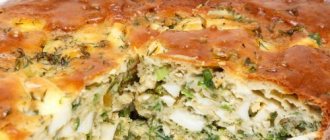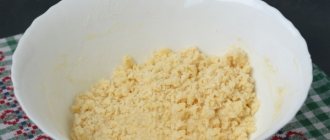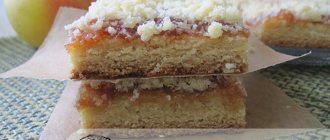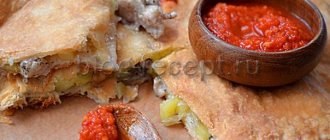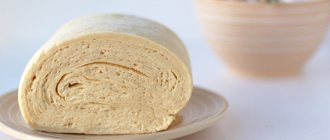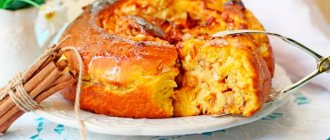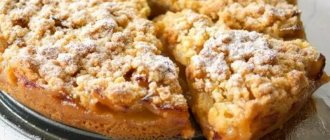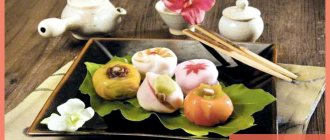I would like to offer you a simple recipe with an interesting story - this is plum pie from the New York Times newspaper. The recipe is actually simple, even those who are not familiar with baking can handle it. Despite this, it turns out very tasty and beautiful, it’s not for nothing that it is so popular among American housewives.
Why is the history of the pie interesting? Believe it or not, the New York Times published this recipe for 12 years in a row.
It was first published in September 1983. The plum season was just beginning and culinary section editor Marian Burros decided to publish her friend’s recipe. After its publication, the newspaper’s editors received rave reviews all year and decided to repeat the publication the next season.
And this is where the fun begins. Apparently the Americans liked it and before the start of the next season they began sending letters to the editor with questions:
“Isn’t it time to publish a recipe for plum pie? or “Are you planning to publish a plum pie recipe this year?”
Under pressure from readers, the editors were forced to print the recipe year after year. But in 1995 they decided to do it one last time. They reported this in the newspaper and invited lovers of this pastry to cut out the recipe and save it.
This is such an interesting story. I also advise you to save this recipe, as well as the recipe for raspberry puffs, which is on the site.
American Plum Pie from the New York Times
If you are not yet familiar with this famous recipe, then I recommend that you bake this popular American pie from the New York Times, which is now the only name they call it. It’s simple and quick to make—ideal for busy housewives.
In different sources you can find discrepancies in the recipe. I think this is due to the fact that in the original recipe, flour, butter, sugar are measured in cups. This is not very convenient, so modern housewives have converted measuring cups to grams. But since the volume of the cups is different, the recipes may differ slightly from each other.
Ingredients:
- butter - 120 gr.
- granulated sugar - 170 gr.
- eggs - 2 pcs.
- flour - 160 gr.
- baking powder - 1 tsp.
- a pinch of salt
- plums - 10−12 pcs.
- 20 g sugar + cinnamon - for topping
Do not use overripe fruits in baking; they should be ripe but firm.
How to Make Plum Pie Based on the New York Times
- We take the butter out of the refrigerator in advance; we need it soft, but under no circumstances do we heat it!
- Place the butter in a bowl, add sugar and mash with a fork.
- Break the eggs into the mixture. Mix. You can use the same fork, or you can use a mixer.
- Sift flour mixed with baking powder and salt into a bowl.
- Mix and get a dough. Look at its consistency. It should not be liquid, but not thick either. Like thick sour cream. If it is liquid, add flour; it cannot become too thick.
- I took a ceramic baking dish. Just grease this one with a piece of butter and lightly dust it with flour. If you have a pan with a non-stick coating, it is better to line the bottom with baking paper, and then also grease the sides and paper with oil, then sprinkle with flour.
- Transfer the dough into the mold. Level it with a spatula.
- We need plums that are ripe, but not overripe, so that they hold their shape well. Cut them in half and remove the pit. Although, the list of products indicates 24 halves, i.e. 12 whole plums, their exact quantity depends on the variety and, accordingly, size. I wouldn't recommend laying it too tightly. It took me 6 plums (12 halves).
- Place them cut side up, pressing them slightly into the dough. Do not deepen them too much; the dough will rise in the oven and may completely hide them.
- Mix together 2 tbsp. sugar and 1 tsp. without a heap of ground cinnamon. Sprinkle this mixture on top of the pie.
- Place to bake in an oven preheated to 180°C (360 degrees Fahrenheit equals 176.67 degrees Celsius). The baking time is quite long - 40-50 minutes. You may need to cover the top with foil while baking. Watch the crust.
- Cool the finished pie in the pan. I didn’t take it out of the ceramic one at all, there’s no need for that. You will have to get another one from another. But first it’s better to let it cool a little, not completely, so that the caramelized plum juice mixed with sugar, which has leaked under the bottom of the pie, does not freeze completely.
Very tasty, both warm and cold. You can serve it warm with a scoop of ice cream; it will be a “bomb”!
New York Times plum pie is a legendary pie with a very interesting recipe behind it. American plum pie became a symbol of the passing summer for many Americans at the end of the last century. Marian Berroz, the author of the recipe, dedicated it to the beginning of the season of plums, which were sold everywhere at an attractive price. From 1983 to 1989, the New York Times published Marian Burrose's recipe every September. Readers flooded the editors with letters of gratitude and requests to publish the recipe next season. After six years of publication and a continuous stream of reviews, the New York Times printed the plum pie recipe in large format and even outlined it with a dotted line so that housewives would finally cut it out and stop bothering the editors. After which a statement was made about the last publication of the recipe. What started here! Angry letters poured in, and one reader explained the significance of the annual publication of the pie: “The appearance of this recipe is bittersweet, like the pie itself. Summer is leaving, it is replaced by autumn. Your annual recipe epitomizes this. Don't be angry with us."
Since its first publication, the American Pie recipe has changed slightly. So, in the first version, 1 cup of sugar is indicated, and in the 1989 recipe - three quarters of a glass. Options have appeared with apples and cranberries - other symbols of autumn. Then a summer version of the recipe came out with blueberries and pears. What explains the popularity of plum pie? Its dough is very tender, with a creamy flavor from the butter and a crispy crust. The pie is prepared quickly, if not instantly. Products are always at hand. I stick to the classic recipe and invite you to prepare with me step by step a fragrant symbol of the passing summer. You can get creative and add things to the recipe as you go. I hope that for my readers the publication of this pie will grow into something more than just a recipe.
- 3/4 tbsp. sugar + 2 tbsp. for powder;
- 113 g butter;
- 1 tbsp. flour;
- 2 eggs;
- 1 tsp baking powder for dough;
- a pinch of salt;
- 12 plums of the prune, Hungarian, etc. variety;
- 1 tsp cinnamon.
1. We select plums from which the pit can be easily separated from the pulp. Hungarian and prune plums are also very aromatic, dense and juicy. Cut the washed plums into halves lengthwise and remove the pits. The classic recipe uses 12 small plums.
2. In a separate bowl, mix cinnamon and sugar for dusting. If you are preparing a pie in a small form, about 20 cm in diameter, there is even a lot of this powder.
3. Combine sugar with eggs. The original 1983 recipe calls for exactly 1 cup of sugar, but even with 2/3 cup the pie seems quite sweet.
4. Beat everything into a homogeneous mass until bubbles appear.
5. Add flour to the beaten eggs. It is advisable to sift it. This way we will saturate it with oxygen, and the cake will turn out truly airy. And with the help of a sieve, we will separate solid and foreign particles from the flour, which can spoil the taste of the pie. Now add baking powder, a pinch of salt and add soft butter (or margarine). For convenience, a couple of hours before preparing the cake, we will leave the butter to sit at room temperature, and we will not have to resort to additional softening procedures. By the way, the original recipe says that it is not necessary to add salt, but it is a natural flavor enhancer that will not harm the pie.
6. Thoroughly beat
the dough with a whisk.
You can do it with a spoon, but it takes longer and is more difficult. From the photo in the recipe you can see that the consistency of the dough is thick, and the color depends on the eggs. 7.
Line of small springform pan with parchment paper.
Grease the walls with oil so that the cake separates well. Cover the bottom of the springform pan
parchment paper and grease the walls
with oil.
8. Place thick dough into the mold.
9. Level the mass with a spoon.
10. Place the plums on top, cut side up, so that they are well baked. From halves of plums you get “boats” in which the aromatic plum juice will be retained. We do not press down the halves; during the baking process they will sink a little due to the fact that the dough rises. If the fruits are large, you will need less of them than indicated in the list of ingredients. It is necessary that they all fit evenly into the mold.
The plum trees at the dacha have finally grown. The harvest was enough not only to eat delicious fruit, but also to bake a plum pie according to the New York Times recipe. This pastry interested me in its simple preparation and also in its history.
Believe it or not, the New York Times published this recipe for 12 years in a row. It was first published in September 1983. The plum season was beginning and culinary section editor Marian Burros decided to publish her friend’s recipe.
After publication, the editors received rave reviews throughout the year and decided to publish it again next season. Then, under the pressure of readers, again and again. Before the start of the next plum season, the editor began to receive letters with questions:
“Isn’t it time to publish a recipe for plum pie?
“Are you planning to publish a recipe for plum pie this year?”
In 1995, the last publication was made; the editors warned readers about this, suggesting that they cut out the recipe and save it.
I suggest you try baking this popular American pie from the New York Times, that’s what they call it now. It’s simple and quick to make—ideal for busy housewives.
New York Times plum pie recipe
- You will need soft butter for baking, so you need to remove it from the refrigerator in advance.
- Soft butter needs to be ground with sugar. You can do this in any way available to you - with a spatula or using a mixer. The main thing is not to overdo it; you should get a light, creamy, homogeneous mass.
- We begin to introduce eggs. If you knead the dough with a spatula, it is better to add the eggs one at a time - it will be easier and better for them to combine with the oil mixture. If you use a mixer, you can add both eggs at once.
- The cake flour must be sifted. Then add salt and baking powder to it, mix well. Knead the dough by adding flour to the egg-butter mixture. The dough should be smooth, sticky, but not runny.
- Grease a springform pan with a diameter of 26 cm with butter. Use a spatula to spread the dough evenly over the pan.
- Prepare the plums. They need to be washed, dried, broken into halves, removing the pit.
- Place the plum halves, cut side up, on the dough in a circle. Leave the center free, do not put the plum there. This will make it easier to cut the finished baked goods into pieces.
- Sprinkle sugar and cinnamon on top of the pie. If you don't like cinnamon, you don't have to put it in.
- Bake in an oven preheated to 180 degrees. Baking time 35 - 40 minutes. Determine readiness by inserting a toothpick into the center. When you take it back out, it should be dry. After cooling slightly, remove the finished baked goods from the mold. Cut into portions and serve.
The recipe states that the plums should be placed cut side up. This is explained by the fact that the juice that the fruit releases during cooking will not spread completely and the baked goods will not be moist.
Plum pie from the New York Times is very beautiful and delicious. Due to the sugar sprinkled on top, the plum fruits are slightly caramelized, retain their shape and pleasantly combine with the delicate, creamy taste of the baked dough. Be sure to make this famous American pastry.
Bon appetit!
Plum pie from Yulia Vysotskaya - video recipe
The dough in this recipe is very similar, but it has its own twist, I wanted to try it, maybe it will interest you too.
Elena Kasatova. See you by the fireplace.
American cuisine contains many dishes that have gained popularity outside their home country. However, there are also those that were very significant some time ago, but today are undeservedly forgotten. The recipe for plum pie, published weekly by a New York Times editor for 12 years, is one of them.
PLUM CAKE
I've lost count of how many messages I've received asking for a plum pie recipe. I’m really ashamed that I’ve recently been absorbed in buying ovens, assembling furniture and laying out wiring, and you sadly look at your drains and don’t know what to do with them.
The typical plum pie offered in all the magazines turns out to be terribly sour. This is when you put plums in a shortcrust pastry basket, sprinkle them with sugar and hope for the best. Abandon hope, everyone who enters here! Plums are not like apples; such things won’t work with them. Well, unless you come from a tribe of little sour eaters and chew lemons for breakfast.
Plums are very similar to cherries in terms of baking. Same sour taste, same juiciness. So you can safely take your favorite recipe with cherries and replace the cherries with plums.
However, plums, unlike cherries, love spices, love caramel, butter, and in this sense are more like peaches and apples. So if you want to get the most out of the plums in your cake, start with this classic plum cake recipe.
I spotted this recipe on my favorite American blog, smitten kitchen (the photo is also from there), but in fact this is the most classic plum recipe, like our charlotte. And just as simple as you understand.
Our teto is made from cakes and is made simply. Cream the butter and sugar, add the eggs one at a time, and stir in the dry ingredients in 10 motions. If you've made one cupcake in your life, you know how to make them all.
1 cup (125 g) flour 1 tsp. (5 g) baking powder pinch of salt
0.5 tsp nutmeg 0.5 tsp. cinnamon
1 cup (200 g) sugar 120 g butter, room temperature 2 large eggs 12 blue plums, halved
Additionally
2 tsp lemon juice, 0.5 tsp. cinnamon and 2 tbsp. Sahara
Mix all dry ingredients except sugar in a bowl. Mix thoroughly, preferably with a whisk.
Meanwhile, beat sugar and butter until white and fluffy. The fluffier the mixture, the fluffier your pie will be. Without stopping whisking, add eggs one at a time to our whipped butter. We added one, waited until it mixed, added the second. That's it, we won't need the mixer anymore, put it aside.
Pour dry ingredients into a bowl with sugar and mix with wide circular movements from bottom to top. Ideally fit into 10 movements. There is no need to fanatically strive for a homogeneous dough. The flour got wet, and that’s fine. If the dough is a little lumpy, that's ok! The less we stir, the fluffier the cake will be!
Turn on the oven to preheat to 180C. We line with paper and grease the edges of a 24 cm springform pan with butter. 26 cm is possible, but it is not advisable, and no more! Otherwise, the dough will be too thin and the plums will not be able to drown in it.
Place the dough in the mold and place the plum halves on top, butt side up. Press the plums into the dough.
Now sprinkle the surface with lemon juice and sprinkle with sugar mixed with cinnamon.
Bake the pie for about 45 minutes.
This pie is best baked overnight, covered and let sit overnight. And there is in the morning. That is, let it stand for 6-12 hours. As the cake cools, the plums continue to release their juice, soaking the cake in wonderful plum juice! Mmm, delicious! At least let the cake cool, you won’t regret it!

